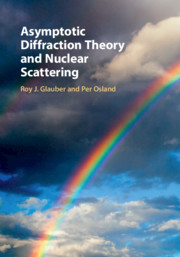Description
Asymptotic Diffraction Theory and Nuclear Scattering
Authors: Glauber Roy J., Osland Per
Presents an explanation of diffractive nuclear scattering in terms of semi-classical trajectories.
Language: English
Subject for Asymptotic Diffraction Theory and Nuclear Scattering:
Publication date: 10-2019
206 p. · 17.8x25.3 cm · Hardback
206 p. · 17.8x25.3 cm · Hardback
Description
/li>Contents
/li>Biography
/li>
Scattering theory provides a framework for understanding the scattering of waves and particles. This book presents a simple physical picture of diffractive nuclear scattering in terms of semi-classical trajectories, illustrated throughout with examples and case studies. Trajectories in a complex impact parameter plane are discussed, and it stresses the importance of the analytical properties of the phase shift function in this complex impact plane in the asymptotic limit. Several new rainbow phenomena are also discussed and illustrated. Written by Nobel Prize winner Roy J. Glauber, and Per Osland, an expert in the field of particle physics, the book illustrates the transition from quantum to classical scattering, and provides a valuable resource for researchers using scattering theory in nuclear, particle, atomic and molecular physics.
Preface; Acknowledgements; List of abbreviations; Part I. Introduction: 1. Overview and preview; 2. Diffraction theory; 3. Asymptotic diffraction theory; 4. Two simple examples; 5. Complex trajectories; 6. Scattering from linear structures; Part II. Various Radial Fall-Offs: 7. Gaussian edge; 8. Exponential edge; 9. Sharper edges; 10. Analytic variations; Part III. Composite Phase Functions: 11. Extended charges; 12. Coulomb plus nuclear interactions; 13. Smooth two-scale functions; 14. Two Fermi functions; 15. Different singularities; 16. Summary; Appendix A. Partial waves and phase shift function; Appendix B. Iteration for stationary points; References; Index.
Roy J. Glauber was Mallinckrodt Professor of Physics (Emeritus) at Harvard University, Massachusetts, and Adjunct Professor of Optical Sciences at the University of Arizona. In 2005, he received half the Nobel Prize in Physics for his contribution to 'the quantum theory of optical coherence'. He received many awards, including the 1985 Albert A. Michelson Medal from the Franklin Institute, the 1985 Max Born Award from the Optical Society of America, and the 1966 Dannie Heinemann Prize for Mathematical Physics from the American Physical Society. He was elected a Foreign Member of the Royal Society (1997), an Honorary Member of the Optical Society of America (2008) and served on the Advisory Board of the Max Plank Institute of Light.
Per Osland is Professor Emeritus at the Department of Physics and Technology, Universitetet i Bergen, Norway. He is a member of the Royal Norwegian Society of Sciences and Letters and a Fellow of the Swedish Collegium for Advanced study. He has held research positions at CERN, Harvard, NORDITA and DESY, and served as chair of the High Energy and Particle Physics Division Board of the European Physical Society.
Per Osland is Professor Emeritus at the Department of Physics and Technology, Universitetet i Bergen, Norway. He is a member of the Royal Norwegian Society of Sciences and Letters and a Fellow of the Swedish Collegium for Advanced study. He has held research positions at CERN, Harvard, NORDITA and DESY, and served as chair of the High Energy and Particle Physics Division Board of the European Physical Society.
© 2024 LAVOISIER S.A.S.

